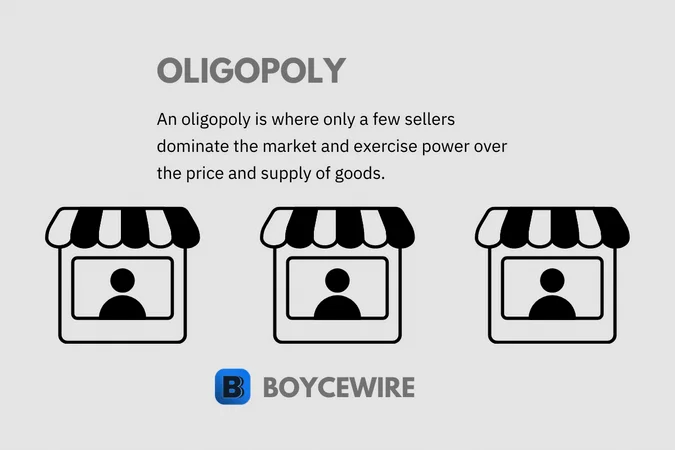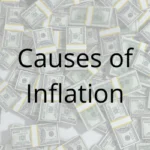Oligopoly: Definition, Characteristics & Examples

What is an Oligopoly?
The term Oligopoly derives from the Latin ‘olígoi’ – meaning “few”, and ‘pōléō’ – meaning “to sell”. So, translated, it means ‘few sellers’. This is one of the main characteristics of an oligopoly – alongside 5 others which we will discuss below.
In economics, an oligopoly is defined as a type of market structure where two or more firms have market control. Combined, they are able to dictate prices and supply. Yet, they are unable to influence the market on their own.
Key Points
- An oligopoly is a type of market structure where two or more firms have significant market power. Collectively, they have the ability to dictate prices and supply
- Generally, a market is considered an oligopoly when 50 percent of the market is controlled by the leading 4 firms.
- An oligopoly can be identified using either the concentration ratio, or the Herfindahl-Hirschman Index.
Firms in an oligopoly can have varying degrees of market share. This could be as significant as 50 percent, or, as little as 5 percent. The point is that the oligopoly is characterised by a few firms no matter their size – as long as a handful of them have enough power to dictate supply and demand.
Oligopolies are also characterised by their interdependent. In other words, they are highly responsive to competitors actions. For instance, if one firm reduces prices, all the others will follow suit to maintain their position in the market.
Characteristics of an Oligopoly
There are 6 main characteristics of an oligopoly. Let us look at these below:
1. A Few Firms with Large Market Share
A market may have thousands of sellers, but if the top 5 firms have a combined market share of over 50 percent, it can be classified as an oligopolistic market. This is because the power is concentrated between a few sellers who are able to exercise power over the market.
2. High Barriers to Entry
Oligopolistic firms maintain their position through a number of barriers to entry. For instance, brand loyalty, patents, and high start-up costs are but to name a few. These make it difficult for new entrants to build a presence in the market and attract customers. In industries such as retail – brand loyalty is a significant barrier to overcome.
These barriers to entry make it difficult for new firms to join and sets it apart from perfect competition. As a result, these barriers to entry allow oligopolies to make higher profits due to limited competition.
3. Interdependence
Any action a firm takes in an oligopolistic market will strongly affect the actions of its competitors. As a result, we have what is often referred to as the ‘Prisoners Dilemma’, under Game Theory. For those who are not familiar with these terms: an oligopolistic firm will operate based on how they believe competitors will react. In other words, Company A expects Company X to reduce its prices, so will do so as well.
This can be sub-optimal as it reduces the power of a competitive market. For example, if Apple was to reduce the price of its iPhone by $200, Samsung would likely follow suit. So when Apple looks to take that decision, they will consider how they will benefit. They won’t receive a boost in demand because the competition is also the same price, so any initial benefit is lost. Often this can lead oligopolistic firms to just maintain the status quo and keep prices constant.
4. Each Firm Has Little Market Power In Its Own Right
Leading on from interdependence; each firm has little market power, because other firms are quick to take advantage. For example, an oligopolistic firm cannot raise prices in fear that customers will flee to its competitors. One oligopolistic firm cannot dictate prices or supply because competitors are equally as ‘powerful’. On an individual basis, this keeps the firm in check. Yet it equally incentivises collusion as one firm is unable to get ahead.
5. Higher Prices than Perfect Competition
Under perfect competition, prices are just above marginal cost, leaving firms with small profits – if any. As oligopolies have combined market power, they tend to keep prices higher to obtain larger profits.
If any firms were to reduce prices, others would also follow suit, thereby reducing profits for all. This is where it becomes tricky in distinguishing between collusion and a natural state of oligopolistic competition. Do firms naturally keep prices higher due to fear that their actions will reduce their profits? Or, do they collude to keep prices and profits high?
6. More Efficient
Oligopolistic firms benefit from high levels of market share. At the same time, they benefit from economies of scale – meaning it can produce at a lower cost. For instance, there are markets that have high fixed costs such as car manufacturers. If new competitors want to enter, they have to spend millions on new factories and other infrastructure.
Consequently, this would increase costs for exisiting firms as the benefit they receive from economies of scale would decline. This means higher prices for customers and it is for this reason that such markets are better served under an oligopolistic market structure.
Examples of Oligopoly
There are many oligopoly examples in today’s society. In fact, the device you are using now may very well be part of an oligopoly. With that said, it is important to realise that an oligopoly is generally defined by its market concentration. In other words, a few firms control the market. Let us look at some examples below:
1. News Media
A few conglomerates own a significant number of media outlets across various platforms. In the US, the market is dominated by the top 6 firms, which account for close to 90 percent of the mass media market: Walt Disney (DIS), Time Warner (TWX), CBS Corporation (CBS), Viacom (VIAB), NBC Universal, and News Corporation (NWSA).

2. Motor Vehicles in US
In the US, the automobile industry is a perfect example of an oligopoly with a few key players, including Ford, Chrysler, General Motors, and Toyota. These companies control the majority of the market share, influence prices, and are mutually interdependent, with a collective market share of close to 60 percent in the US.

3. Mobile Phones
In the mobile phone sector, very few firms dominate the market. In the US, the market is primarily ruled by Apple, Samsung, and Huawei. They dictate the pricing, services, and innovations in the industry – owning a combined market share of over 50 percent of the entire global market.

4. Breakfast cereals
The breakfast cereal industry is dominated by a few major players, namely General Mills, Kellogg’s, Quaker, and Post Holdings. These companies control over 85 percent of the US market and have a significant influence on product variety, pricing, and marketing strategies. Their popular brands such as Cheerios (General Mills), Corn Flakes (Kellogg’s), and Honey Bunches of Oats (Post) are staples in households worldwide.

5. Beer
The global beer industry is a classic example of an oligopoly, with a small number of large breweries including AB InBev (brands include Budweiser, Corona, and Stella Artois), Heineken N.V., SAB Miller, and Carlsberg dominating the market. These companies have a significant influence over the market, from setting prices to driving trends in beer types and tastes – with a market share of over 70 percent.

6. Cellular Networks
The telecommunications industry worldwide is mostly controlled by a few key players in each country. For instance, in the U.S., Verizon, AT&T, Sprint and T-Mobile are the dominant players – owning a combined 98 percent of the total US wireless network market.

7. Music Entertainment
The global music industry is also a form of oligopoly, with four major record labels – Universal Music Group, Sony Music Entertainment, EMI Group, and Warner Music Group – controlling close to 90 percent of the US market. These companies have a significant influence on which artists get signed, what music gets produced, and how it is distributed.

Oligopoly Graph – Kinked Demand Curve
The kinked demand curve is distinctive of an oligopolistic market. It shows how, at higher and lower prices, the elasticity of demand changes. As a result, prices remain relatively rigid.

Copyright: Boycewire
As we can we in the chart above, firms are unlikely to be incentivised to increase or decrease prices.
This is because increasing prices will significantly impact demand. As competitors keep their prices stable, the firm that increases prices will lose customers to cheaper rivals.
At the same time, reducing prices won’t increase demand. This is because price decreases will be met with fierce competition. In an oligopoly, when one firm reduces its prices, the others follow. In turn, any real gains in demand will be negligible.
Now let us take an example of how this works:
| Your Business | Competitor | Result |
|---|---|---|
| You Increase Prices P ↑ | Competitors ignore and keep prices their prices the same P = | Elastic demand. Demand is highly sensitive to price, so a lot of your customers will go to the cheaper competitors. |
| You Decrease Prices P ↓ | Competitors follow suit and reduce their prices | Inelastic demand. As all other competitors follow, demand for your products hardly changes |
How to Tell if a Market is an Oligopoly
Concentration Ratio
The concentration ratio comes in a number of forms: third-firm ratio, four-firm ratio, five-firm ratio, and six-firm ratio. From this, the concentration ratio calculates the market share of the top 3 to 6 firms in the market.
Let us take the automobile industry in the US as an example. If we are to do a four-firm ratio, we would take the leading four companies: General Motors, Toyota, Ford, and Chrysler. Then, we work out their combined market share:
| General Motors: | 17 percent |
| Toyota: | 14.6 percent |
| Ford: | 14.4 percent |
| Chrysler: | 13 percent |
| Total: | 59 percent |
|---|
So according to the four-firm ratio, the automobile industries has a concentration of 59 percent. In turn, we can define this as an oligopoly. This is because for a four-firm ratio; anything over 50 percent could be considered an oligopoly. Similarly, for a five-firm ratio; anything over 60 percent could also be considered an oligopoly.
Herfindahl-Hirschman Index
The Herfindahl-Hirschman Index is a method by which we can tell how concentrated a market is. Most commonly, it is used by the US Department of Justice to consider when to take action in anti-competitive markets.
Quite simply, anything under a score of 1,500 is considered as a competitive marketplace. Anything between a HHI score of 1,500 and 2,500 is considered moderately competitive. And anything over 2,500 is extremely concentrated. For markets with a score of over 1,500; they would classify as an oligopoly, all the way up to 10,000 – which signals a monopoly.
How to Calculate the Herfindahl-Hirschman Index
The HHI is calculated by selecting each firm’s market share. The market share is then squared individually, with the results added together. This can be seen below:
HHI = Business1 ² + Business2 ² + Business3 ² + BusinessN ²
So let us now take an example.
- Business 1 Market Share = 30 percent
- Business 2 Market Share = 20 percent
- Business 3 Market Share = 15 percent
- Business 4 Market Share = 10 percent
The HHI is then calculated as: HHI = 30² + 20² + 15² + 10² = 900 + 400 + 225 + 100 = HHI 1625.
FAQs
An oligopoly is where there are only a few firms that have a dominating share of the market.
Characteristics of an oligopoly include:
1. A Few Firms with Large Market Share
2. High Barriers to Entry
3. Interdependence
4. Each Firm Has Little Market Power In Its Own Right
5. Higher Prices than Perfect Competition
6. More Efficient
Cellular Networks are an example of an oligopoly. In the US, the main players Version, Sprint, AT&T, and T-Mobile, own a combined total of 98 percent of the market.
In the mobile phone market, Apple is part of an oligopoly. To take a case in point, Apple, Samsung, and Huawei own a combined market share of over 50 percent of the entire global market.
Coca-Cola is an oligopoly in the fact that the firm itself owns other brands such as Fanta. The only real competitor of any significance is Pepsi, which owns other brands such as Tango. In turn, both Pepsi and Coca-Cola own the majority of the soft drinks market, therefore qualifying as an oligopoly.
About Paul
Paul Boyce is an economics editor with over 10 years experience in the industry. Currently working as a consultant within the financial services sector, Paul is the CEO and chief editor of BoyceWire. He has written publications for FEE, the Mises Institute, and many others.

Related Topics
Further Reading
 Causes of Inflation: Cost-Push & Demand-Pull - There are three main causes of inflation. They are cost-push, demand-pull, and the velocity by which money circulates in the…
Causes of Inflation: Cost-Push & Demand-Pull - There are three main causes of inflation. They are cost-push, demand-pull, and the velocity by which money circulates in the…  Bounded Rationality: Definition & Examples - Bounded rationality highlights the limitations of humans’ ability to make optimal decisions.
Bounded Rationality: Definition & Examples - Bounded rationality highlights the limitations of humans’ ability to make optimal decisions.  Stagflation - Stagflation is an economic condition characterized by a combination of stagnant economic growth, high unemployment rates, and high inflation.
Stagflation - Stagflation is an economic condition characterized by a combination of stagnant economic growth, high unemployment rates, and high inflation. 